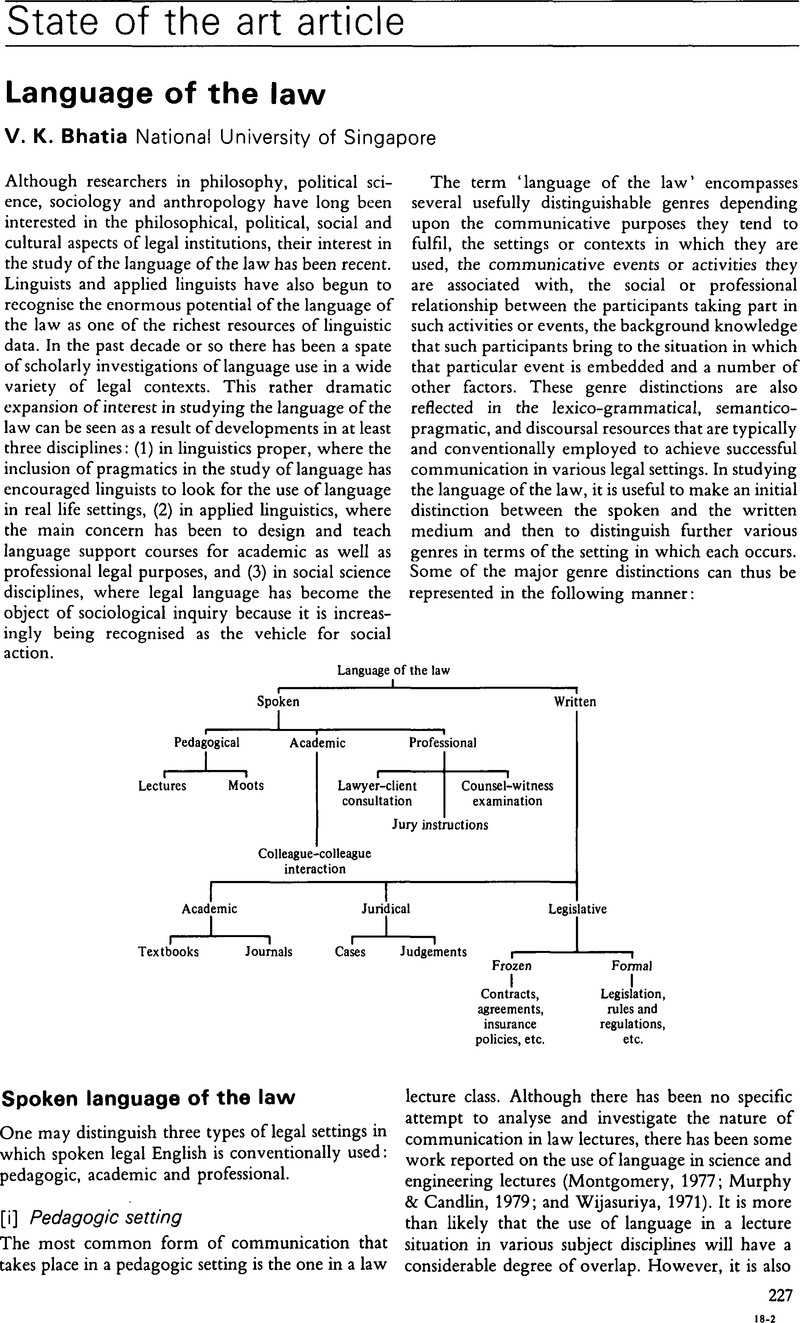Crossref Citations
This article has been cited by the following publications. This list is generated based on data provided by Crossref.
Swanepoel, P. H.
1989.
Botsing tussen leksikografiese beginsel en leksikografiese praktyk; enkele gedagtes oor die terminologiebeleid van dieWAT.
South African Journal of Linguistics,
Vol. 7,
Issue. 1,
p.
6.
Swales, John M.
1990.
Discourse analysis in professional contexts.
Annual Review of Applied Linguistics,
Vol. 11,
Issue. ,
p.
103.
Harris, Simon
1992.
Reaching out in legal education: Will EALP be there?.
English for Specific Purposes,
Vol. 11,
Issue. 1,
p.
19.
Clerehan, Rosemary
1995.
Taking it down: Notetaking practices of L1 and L2 students.
English for Specific Purposes,
Vol. 14,
Issue. 2,
p.
137.
Bowles, Hugo
1995.
Why are newspaper law reports so hard to understand?.
English for Specific Purposes,
Vol. 14,
Issue. 3,
p.
201.
Crosling, Glenda
1996.
Multi-level structure of meaning in a business law tutorial.
Australian Review of Applied Linguistics,
Vol. 19,
Issue. 1,
p.
89.
Kurzon, Dennis
1997.
‘Legal language’: varieties, genres, registers, discourses.
International Journal of Applied Linguistics,
Vol. 7,
Issue. 2,
p.
119.
Candlin, C.N.
Bhatia, V.K.
and
Jensen, C.H.
2002.
Developing legal writing materials for English second language learners: problems and perspectives.
English for Specific Purposes,
Vol. 21,
Issue. 4,
p.
299.
2002.
PhD abstracts (in alphabetical order).
Forensic Linguistics,
Vol. 9,
Issue. 1,
p.
133.
FRADE, CELINA
2007.
Power dynamics and legal English.
World Englishes,
Vol. 26,
Issue. 1,
p.
48.
Hafner, Christoph A.
2010.
A Multi-perspective Genre Analysis of the Barrister’s Opinion: Writing Context, Generic Structure, and Textualization.
Written Communication,
Vol. 27,
Issue. 4,
p.
410.
Jopek-Bosiacka, Anna
2010.
Legal Communication: A Cross-Cultural Perspective.
Northcott, Jill
2012.
The Handbook of English for Specific Purposes.
p.
213.
Ruiz Moneva, Mª Angeles
2013.
Cognition and context of legal texts: spanish and english judgments compared.
Revista de Lingüística y Lenguas Aplicadas,
Vol. 8,
Issue. 0,
Scott, Juliette
2016.
The Ins and Outs of Business and Professional Discourse Research.
p.
117.
Karjo, Clara Herlina
2016.
Problems in Translating Legal English Text into Indonesian.
SSRN Electronic Journal,
Clarke, Jumani
2017.
The rhetorical structure of students’ legal problem essays: Towards a systemic comparison of student texts.
Southern African Linguistics and Applied Language Studies,
Vol. 35,
Issue. 1,
p.
63.
Fanego, Teresa
Rodríguez-Puente, Paula
López-Couso, María José
Méndez-Naya, Belén
Núñez-Pertejo, Paloma
Blanco-García, Cristina
and
Tamaredo, Iván
2017.
The Corpus of Historical English Law Reports 1535–1999 (CHELAR): A resource for analysing the development of English legal discourse.
ICAME Journal,
Vol. 41,
Issue. 1,
p.
53.
Moessner, Lilo
2018.
Sociocultural Dimensions of Lexis and Text in the History of English.
Vol. 343,
Issue. ,
p.
103.
Das, Veena
2019.
A child disappears: Law in the courts, law in the interstices of everyday life.
Contributions to Indian Sociology,
Vol. 53,
Issue. 1,
p.
97.



